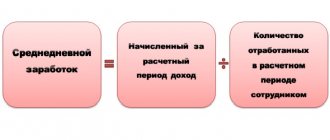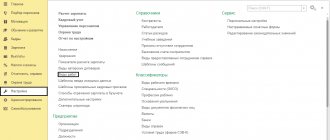With the modern rhythm of life, it is not always convenient for an employee to devote the whole day to work, and to pay the head of the company a full salary. In this regard, the concept of “part-time work” has already become firmly established in our lives. The employee, during the allotted time, will try to demonstrate his maximum abilities and output in order to go home sooner, and the director will be able to save a lot, since payment is made for a specific period worked. We’ll tell you about calculating wages for part-time work, and give examples with amounts and postings.
Payment methods, procedure and calculation formula
To learn how to correctly calculate the amount of payments, you need to clearly understand how a certain type of salary is calculated.
| Forms of payment | Calculation procedure |
| Time-based | Depends only on the amount of time worked, the amount of products produced does not affect this form of payment |
| Piecework | The calculation procedure is inversely proportional to the previous form. Payments are made only for the amount of work done, regardless of the time spent on it. |
In addition, the salary can be divided into:
Main:
- salary or piece income;
- bonuses for a job well done;
- other surcharges.
Additional:
- payment for required vacation and sick leave in case of incapacity for work;
- reimbursement of expenses incurred in connection with travel, accommodation and meals (for example, during business trips);
- bonus payments that are not part of the main employment agreement.
The established calculation formulas are applied depending on the forms of remuneration:
- For piecework wages, the following calculation is used: Salary = cost of production specified in the contract * volume of products produced for the period + accrued bonuses + other additional payments – income tax – other deductions.
- Time-based payment is calculated using the formula: Salary = salary amount / total number of working days * number of days actually worked + bonus amount - personal income tax - withheld amounts . Read also the article: → “Calculating salaries for employees (piecework, temporary payment, calculation example).”
The above formulas are relevant when the employment contract states that the terms of employment are part-time and the employee has worked the required hours.
Payroll calculation for part-time work
When an employee has not fully worked the required hours, the calculation algorithm will be different:
| Period | Formula |
| Calculation for less than a month | Salary for an incomplete month = the value obtained by calculation using the formula for the standard calculation of payments due / number of working days for a certain period * number of days actually worked. |
| Calculation for the day worked | Wages for one day = value obtained by calculation using the formula / number of working days in the period. |
| Calculation for the year worked | Average salary per day = amount of salary for the year / number of months / 29.3. |
| Calculation of wages with a vacation break | Wages, if there was a vacation in the billing period = employee’s salary / total number of working days in the period * number of days actually worked in the month. |
Calculation of wages at a salary rate at a rate of ½ or ¼:
- Salary at ½ rate = salary at full rate*0.5
- Salary at ¼ rate = salary at full rate *0.25
Calculation example No. 1. Employee Kovalev A.A. drawn up under an employment contract, rate - ½, from November 11, 2016 to the position of equipment sales manager. The full salary for this position is 25,000, according to the staffing table. Calculate wages for less than a month.
First you need to determine the number of working days and weekends that fell in November:
- workers - 21 days;
- weekend - 9 days.
From November 11 to November 30, the employee worked 14 days. Next, the calculation is carried out according to the formula: 25,000 / 21 * 14 = 16,666.67 rubles - wages for the period from November 11 to November 30. The rate of Kovalev A.A is ½, accordingly the amount of payment will be:
Salary for November = 16,666.67*0.5=8,333.34 rubles
Under piecework conditions, the calculation is much simpler. It is enough to know the amount of payment per unit of production and the quantity of goods sold.
Legal documents
The rules for determining average earnings are regulated by Art. 139 of the Labor Code of the Russian Federation and Government Decree No. 922 dated December 24, 2007 (as amended on December 10, 2016). The method for calculating the “average” is the same for all employers, it does not depend on:
- organizational form of the organization;
- wage systems;
- work and rest schedule of employees.
The fact that an employee works part-time does not affect the procedure for calculating his average earnings.
Minimum payout amount
According to Article 133 of the Labor Code, if an employee has fully worked the time established by the employment agreement, the amount of his remuneration should not be lower than the minimum wage (minimum wage). For example, in 2021 this figure in Moscow is 17,561 rubles. Under working conditions at a rate of ½, wages cannot be less than 8,780.50 rubles, that is, in proportion to the established minimum:
Salary = 17,561*0.5 = 8,780.50 rubles
Calculation example No. 2. The Podsolnushko farm in the Krasnodar Territory had two employees in 2021: tractor driver Klyuev and driver Petrov. Klyuev is employed full-time and his salary is 11,000 rubles, Petrov works at a rate of ½ and his salary is 5,000 rubles. We will determine whether these payments in the prescribed amount do not violate labor laws.
The minimum wage in the Krasnodar region in 2021 was 10,366 rubles. Klyuev’s salary exceeds this value, and therefore management does not violate his rights. But in relation to Petrov, their actions are illegal, since his rate is ½, then the amount of payment should not be less than 5,183 rubles.
It is worth remembering that the minimum wage in different regions is set individually. The table shows how the indicators differ. It all depends on the different levels of inflation in different regions and on the established cost of living. Wages for part-time work may be less than the minimum wage, but only in proportion to the rate.
| Region | Minimum wage size in 2021 |
| Bryansk region | 7,500 rubles |
| Murmansk region | 13,650 rubles |
| Tyumen region | 7,700 rubles |
| Moscow | 17,300 rubles |
What is part-time working time according to the Labor Code of the Russian Federation?
The concept of underemployment is given in Stat. 93 Labor Code of the Russian Federation. This regime can be established for an employee by mutual agreement with the employer. You can register an employee on a part-time basis immediately upon initial employment or during further work. The period may or may not be limited.
For certain categories of personnel, the employer is obliged to establish part-time work upon receipt of a request from such a specialist. These are, for example, pregnant women, parents of children under 14 years of age or children with disabilities under 18 years of age, etc. If an employee works part-time, his salary is calculated in proportion to output (by time or volume). The part-time regime does not entail any restrictions regarding annual leave or calculation of length of service.
Pre-holiday days with part-time work
Labor legislation stipulates that the pre-holiday day should be shortened by one hour. Employees registered at 0.5 rate also have the right to use this privilege. This benefit does not apply to the category of workers whose work should not be interrupted. The employer, in turn, can compensate for unused benefits with payments or additional rest.
Pre-holiday days are the days before official holidays. Their list is established long before the start of the calendar year and is available in any information source, along with the production calendar. If an official holiday falls on a Monday, then Friday is not a pre-holiday day.
Which days are considered pre-holidays: (click to expand)
- This category includes workdays on the eve of a holiday. For example, if February 23 falls on a Monday, then Friday does not fall under this definition and cannot be a shortened day.
- Religious customs established in the respective regions are also considered federal holidays. For example, Parents' Day in the Krasnodar Territory has been a day off for many years, by decree of the governor. And in Moscow it’s an ordinary working day.
For part-time workers who doubt their rights, the labor code states: employees registered at ½ rate have the same advantages and benefits along with everyone else: the right to paid leave, accrual of seniority and others. Based on this, employees who work part-time also work an hour less, and proper documentation of this fact is mandatory:
- Drawing up an order establishing a working hours schedule, which will clearly define this range, taking into account the lunch break;
- Instead of 8 hours worked, the timesheet must indicate 7, and for part-time workers, instead of 4, enter the number 3.
How to calculate the average monthly salary of an employee if he has not worked for a month?
- 1. What is average earnings and how to determine it
Average earnings are the employee’s average salary for the billing period, calculated in accordance with the established procedure.
For most cases, a single procedure has been established for calculating average earnings - using average daily earnings. An exception is the calculation of average earnings in the case of cumulative accounting of working hours (Article 139 of the Labor Code of the Russian Federation, clause 9 of the Regulations on average wages). Average earnings are calculated using the formula:
The number of days in the period subject to payment is determined in calendar or working days, depending on the basis for maintaining average earnings. Thus, to pay for vacations granted in calendar days and to pay compensation for unused vacations, calendar days must be used, and in all other cases provided for by the Labor Code of the Russian Federation, working days (Clause 9 of the Regulations on Average Wages, Decision of the Supreme Court of the Russian Federation dated May 25, 2006 N GKPI06-366).
Attention! If there are non-working holidays in the period subject to payment, then the employee who received the salary receives severance pay (average earnings) on the grounds provided for in Art. 178 of the Labor Code of the Russian Federation, we recommend paying also for these days (Resolution of the Constitutional Court of the Russian Federation dated November 13, 2019 N 34-P (included in paragraph 7 of the Review of the practice of the Constitutional Court of the Russian Federation for the fourth quarter of 2021, in paragraph 26 of the Review of practice of the Constitutional Court of the Russian Federation for 2021)).
To calculate average daily earnings (except for the case of calculating vacation pay and compensation for unused vacation), you must:
- determine the billing period for which the average daily earnings are determined (the number of days worked in this period);
- determine the amount of wages, including bonuses and remunerations included in the calculation;
- divide the amount of wages for the billing period (clause 2) by the number of days worked in the billing period (clause 1).
What is the billing period for determining average earnings?
For all cases provided for by the Labor Code of the Russian Federation, a billing period of 12 calendar months preceding the period in which average earnings is maintained is established (Article 139 of the Labor Code of the Russian Federation, clause 4 of the Regulations on Average Wages).
The time when :
- the employee retained his average earnings (with the exception of breaks for feeding the child) (clause “a”, paragraph 5 of the Regulations on average wages);
- the employee received benefits for temporary disability, pregnancy and childbirth (paragraph “b”, paragraph 5 of the Regulations on average wages);
- in other cases, the employee did not work (was released from work) with full or partial retention of salary or without payment (clauses “c” - “f” of paragraph 5 of the Regulations on Average Wages).
When calculating average earnings , non-working days established by Decrees of the President of the Russian Federation in connection with the spread of coronavirus, exclude from the calculation period (if they were in this period) on the basis of paragraphs. “e” clause 5 of the Regulations on average wages (Letter of the Ministry of Labor of Russia dated May 18, 2020 N 14-1/B-585).
June 24, 2021 By Decree of the President of the Russian Federation, it was declared a non-working day with continued pay. For this day, the employee must receive as much as he would have received if he had worked it in full (worked the standard working hours with time-based payment, fulfilled the standard of work with piecework payment). An employee who worked on this day due to the specifics of the organization’s activities must receive payment in the usual and not increased amount (Letters of the Ministry of Labor of Russia dated June 17, 2020 N 14-1/B-733, dated June 17, 2020 N 14-1/B -727).
July 1, 2021 is a non-working day, which is paid in accordance with the Labor Code of the Russian Federation as a non-working (holiday) day. For those who did not work on this day, wages for July were not reduced, and those who worked on this day were paid double (paragraph 2, part 5, article 2 of the Law of the Russian Federation on the amendment to the Constitution of the Russian Federation dated 03/14/2020 N 1-FKZ, part 4 of article 112 of the Labor Code of the Russian Federation, Letter of the Ministry of Labor of Russia dated 06/17/2020 N 14-1/B-727, Information from Rostrud dated 06/15/2020).
If employees were released from work on June 24 and July 1, 2021, then when calculating average earnings, exclude these days from the calculation period (if they were in this period) based on paragraphs. “e” clause 5 of the Regulations on average wages (Letter of Rostrud dated July 20, 2020 N TZ/3780-6-1).
If employees were not released from work during the period of validity of the Decrees of the President of the Russian Federation and the Law on Amendments to the Constitution of the Russian Federation, including June 24 and July 1, 2021, and their work time sheets indicate working days, then this period and the amount of payments take it into account when calculating average earnings in the established art. 139 of the Labor Code of the Russian Federation and Regulation No. 922 (Letter of Rostrud dated July 20, 2020 No. TZ/3780-6-1).
What payments are taken into account when calculating average earnings?
To calculate average earnings, payments to employees provided for by the organization’s wage system are taken into account, for example (Article 139 of the Labor Code of the Russian Federation, clause 2 of the Regulations on average wages):
- wages accrued to employees, regardless of the applied wage system (clauses “a” - “c” of clause 2 of the Regulations on Average Wages);
- allowances and surcharges to tariff rates, salaries for professional skills, class, length of service (work experience), knowledge of a foreign language, combination of professions (positions), expansion of service areas, increase in the volume of work performed, team management, etc. (paragraph “to” » clause 2 of the Regulations on average wages);
- payments related to working conditions (clause “l”, clause 2 of the Regulations on average wages);
- bonuses and rewards provided for by the remuneration system (clause “n”, clause 2 of the Regulations on average wages);
- other types of payments (clause "o" clause 2 of the Regulations on average wages).
The calculation of average earnings does not include :
- payments of a social nature, as well as payments not related to wages (material assistance, payment of the cost of food, travel, training, utilities, recreation, etc.) (clause 3 of the Regulations on average wages);
- amounts accrued for the time excluded from the billing period (clause 5 of the Regulations on average wages). In particular, if in the billing period there were non-working days established by Decrees of the President of the Russian Federation in connection with the spread of coronavirus, and non-working days of 06/24/2020 and 07/01/2020, then do not take into account the amounts accrued for this period on the basis of paragraphs. “e” clause 5 of the Regulations on average wages (Letters of the Ministry of Labor of Russia dated May 18, 2020 N 14-1/B-585, Rostrud dated July 20, 2020 N TZ/3780-6-1).
How to calculate average daily earnings (except for cases of calculating vacation pay and compensation for unused vacation)
Average daily earnings for cases provided for by the Labor Code of the Russian Federation, in addition to calculating vacation pay and compensation for unused vacation, are determined by the formula (clause 9 of the Regulations on average wages):
If the employee did not have an actual accrued salary during the billing period, the average earnings are determined depending on the situation:
- based on the salary accrued to him for the period preceding the calculation period and equal to it, provided that in this period he had days worked and accrued salary (clause 6 of the Regulations on average wages);
- based on the salary actually accrued for the days actually worked in the month of occurrence of the event that is associated with maintaining the average earnings, provided that the employee did not work before the start of the billing period (clause 7 of the Regulations on the average salary);
- based on the tariff rate, salary - provided that the employee did not work before the start of the billing period, and before the occurrence of an event related to the preservation of average earnings (clause 8 of the Regulations on average wages).
An example of calculating average earnings in the absence of wages in the billing period
Malyshkova Yu.M. submitted a medical certificate for blood donation on April 16, 2021 and an application for an additional day of rest on April 17, 2021.
The employment contract with the employee established the start date of work - April 2, 2021 and the salary - 30,000 rubles. In the example, we assume that the organization is not subject to the Decrees of the President of the Russian Federation establishing non-working days in connection with coronavirus.
In the billing period from April 2021 to March 2021 and earlier, the employee had no working days and no accrued earnings. This means that average earnings need to be calculated based on earnings for days actually worked in the period from April 2 to April 15, 2021 (10 working days) - RUB 13,636.36. (RUB 30,000 / 22 days x 10 days).
Average daily earnings are:
RUB 1,363.64 (RUB 13,636.36 / 10 days).
For the day of blood donation and an additional day of rest, the employee should be accrued an average salary in the amount of 2,727.28 rubles. (RUB 1,363.64 x 2 days). Ready-made solution: How to calculate average earnings (ConsultantPlus, 2021) {ConsultantPlus} 2 . Calculation of average earnings in cases not related to vacation pay
According to subparagraphs 9 and 13 of the Regulations on Average Earnings, the formula for calculating average earnings (AS) is as follows:
SZ = SZdn x KAdd = (Amount ZPrp : KDotr) x KAdd
or
SZ = SZhour x KChopl = (Sum of ZPrp : KChotr) x KChopl,
where SZdn is the average daily earnings;
KDopl - the number of working days in the period for which average earnings are maintained;
ZPrp - the amount of wages accrued for the billing period;
KDotr - the number of days actually worked in the billing period;
SZhour - average hourly earnings;
KChopl - the number of working hours in the period for which average earnings are maintained;
KChotr - the number of hours actually worked in the billing period.
Since the average earnings in all cases not related to vacation pay are retained only for working days (hours) according to the employee’s schedule falling during the period when the employee was absent from the workplace for good reasons or could not perform his job duties, the calculation of the average daily earnings should also be carried out based on the days (hours) actually worked according to the employee’s schedule .
The payment procedure does not change if some months of the billing period are not fully worked out . In any case, the days (hours) falling within the billing period are taken into account, which are indicated in the Working Time Sheet with the codes “I” (“01”) , “N” (“02”) and “RV” (“03”) , and wages accrued for the billing period. “Salaries in 2021” (23rd edition, revised and expanded) (E.V. Vorobyova) (“IC Group”, 2020) {ConsultantPlus}
- Question: A company employee, while working, caused harm to a third party through his careless actions by damaging a car. A third party sent a claim to our company for repayment of the amount of damage, which, according to the assessment results, amounted to 60,000 rubles. An explanatory statement was taken from the employee, in which he did not deny his guilt. An internal inspection was carried out, as a result of which the employee was reprimanded and an order was issued to recover material damage from the employee. Collection shall be made in accordance with Art. 138 of the Labor Code of the Russian Federation monthly in an amount not exceeding 20% of monthly earnings, up to the recovery of the entire amount of average monthly earnings, the amount to be recovered from the employee is 25,000 rubles. However, after these documents were published, the employee wrote another explanatory note, in which he denies his guilt and believes that the amount of 25,000 rubles does not correspond to his average monthly earnings. How and for what period is the average monthly earnings calculated in this situation (including personal income tax or excluding personal income tax, and for what calculation period), and what are the further actions of the employer in this situation?
Answer: In the absence of the employee’s consent to deduct from wages, the employer’s actions to withhold funds from wages to reimburse car repairs are considered unlawful. If the employee refuses compensation for damage, the employer has the right to file a claim for recovery in court.
To calculate the average monthly earnings (average wage) of an employee, all types of payments provided for by the remuneration system are taken into account (wages, allowances, additional payments, bonuses and rewards, etc.)
The average salary of an employee is calculated based on the salary actually accrued to him and the time he actually worked for the 12 calendar months preceding the period during which the employee retains his average salary. {Question: A company employee, while at work, inadvertently caused harm to a third party by damaging a car. The employee is required to recover material damages. How and for what period is the average monthly salary calculated in this situation, and what are the further actions of the employer in this situation? (“Website “Onlineinspection.RF”, 2020) {ConsultantPlus}}
- The legislation does not establish a special procedure for calculating earnings for the purposes of financial recovery. Therefore, you can calculate it according to the general rules applied for all cases of maintaining an employee’s average monthly earnings for any period other than vacation <31>.
From authoritative sources
Kovyazina Nina Zaurbekovna, Deputy Director of the Department of Education and Human Resources of the Russian Ministry of Health
“The legislation does not provide for separate rules for calculating average earnings for cases of withholding compensation from an employee for damage caused to him.
It is necessary to use the general calculation rules established by Art. 139 of the Labor Code of the Russian Federation and the Regulations on the specifics of the procedure for calculating average wages <32>. Divide the total salary for the 12 months before the month of damage by the number of days (hours) worked in those 12 months. Multiply the resulting value by the number of working days on the schedule of the employee who caused the damage in the month the damage was caused.”
Article: How to recover damages from an employee when the company’s losses are his own doing (Kokurina M.A.) (“General Book”, 2014, No. 14) {ConsultantPlus}
Comments Calculation example
Example: June 2013, 8 days worked, salary 4,000 rubles. July 2013 - 9 days - 4500 rub. August 2013 - 9 days - 4500 rub.
Average daily earnings = (4000+4500+4500)/(8+9+9)=500 rubles. /day
If the company has a 5-day working week, then in June, July and August there were 19, 23 and 22 working days, respectively. That is, the average monthly number of working days = (19+23+22)/3=21, 333 days
Therefore, the average salary for calculating unemployment benefits = 500 * 21, 333 = approximately 10,666 rubles.
Sincerely, HR specialist Nadezhda Denisenko.








